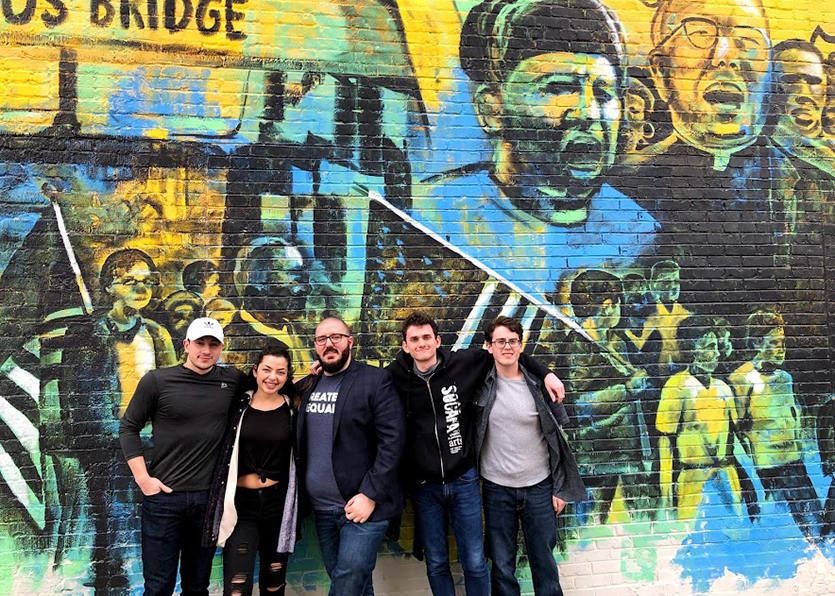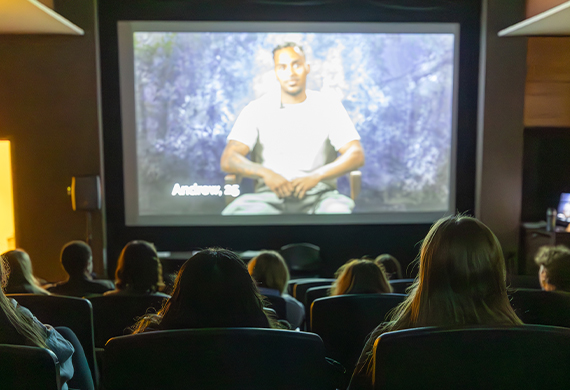Walking in History’s Footsteps

Five Marist students headed south for spring break–on a journey to retrace the most important moments of the Civil Rights Movement.
Professor of History Robyn Rosen and Assistant Professor of History Steven Garabedian designed the special topics class “Race in America” as a way for Marist students to understand the central role race has played throughout American history. From slavery to the Civil War and from Jim Crow to the Civil Rights Movement, it forms part of the fabric of the nation.
So what better way to experience history firsthand than to visit some of the most famous landmarks in the African American struggle for freedom? From March 16-23, Rosen and five students from the “Race in America” class did just that, participating in an emotional trip throughout the American South that brought to life everything the students have been learning in the classroom all semester. Rosen was joined on the trip by Raquelle Rocco ’21, a history major from Parsippany, New Jersey; Joseph Sarci ’20, a history major/communication minor from Ponte Vedra Beach, Florida; Joshua Socher ’21, an English major from Greenwich, Connecticut; Andre Beliveau ’19, a history major/American studies minor from Bethlehem, Pennsylvania; and Ryan Stevens ’21, a history major/philosophy minor from Midland Park, New Jersey. Together, they drove all over the South, covering four states in a week.
The group’s journey began in Birmingham, Alabama, where stops included the Civil Rights Institute, the 16th Street Baptist Church (where a 1963 bombing claimed the lives of four young black girls), and the home and church of minister and civil rights activist Fred Shuttlesworth. That was followed by a visit to Forsyth County, Georgia, which was the site of an infamous 1912 racial expulsion; that event was chronicled in Patrick Phillips’ book Blood at the Root, which the students read for class. Rosen and the students then traveled to Montgomery, Alabama, state capital and site of the famous Montgomery bus boycott. Highlights of the visit to this historic city included the new National Lynching Memorial (also known as the National Memorial for Peace & Justice) and the Equal Justice Initiative Legacy Museum. The students also spent time at the Rosa Parks Museum, the Civil Rights Memorial Center, the Alabama Department of Archives & History, and the Dexter Avenue Baptist Church, where Dr. Martin Luther King, Jr. served as pastor.
Students visiting the Southern Poverty Law Center’s Civil Rights Memorial Center in Montgomery, Alabama.
The weight of so much history was not lost on the students. In fact, Socher describes it as one of the most significant weeks of his life. As he tells it, “Visiting the civil rights landmarks I’ve studied was nothing short of surreal. At times, the trip was heartbreaking, since each museum and memorial was a reminder of cruelty and oppression, but at the same time, it was inspiring to meet people who have dedicated their entire lives to continuing the legacy of people like Dr. King. Traveling around the South with this group of people who share a passion for civil rights and equality was so special.” Says Rosen, “One of the most meaningful parts of the trip for me as an educator was watching my students take their knowledge and critical thinking skills out into the world. Their reactions to the exhibits were so discerning and sophisticated because they already had a depth of knowledge to build upon.”
The group’s tour continued to Selma, Alabama and the Edmund Pettus Bridge, where in 1965 peaceful civil rights marchers were violently attacked by law enforcement in one of the most notorious incidents of the era. Jackson, Mississippi was the next stop on the trip. Here, Rosen and the students visited the Museum of Mississippi History and Mississippi Civil Rights Museum, which featured a special exhibit called “Spirits of the Passage.” This powerful exhibit was centered on the trans-Atlantic slave trade and contains artifacts recovered from a sunken slave ship. The unique spring break trip came to an end in Memphis, Tennessee, home of the National Civil Rights Museum at the Lorraine Motel. The Lorraine Motel became famous in 1968 when Dr. King was assassinated there.
Professor Robyn Rosen and students at the Edmud Pettus Bridge in Selma, Alabama.
Apart from the opportunity to visit nationally significant historic sites, the trip also offered students the chance to actively reflect on how history is told. Notes Rosen, “The students noticed small but significant details and differences in the historical narratives being offered in the various museums we visited. We talked a lot about whether exhibits used the word ‘revolution’ or ‘revolutionary’ to describe the freedom struggle, which groups and people were highlighted and who was omitted, which museums connected the dots back to enslavement and Jim Crow, and which ones tackled contemporary civil rights issues like mass incarceration and criminal justice reform.” These profound conversations proved to be one of the most valuable parts of the experience for both Rosen and the students, enhancing the learning that occurs in the classroom. Adds Stevens, “Having the opportunity to travel the South and grapple with both competing and complementary historical narratives of racial injustice was invaluable, to say the least. History is not just a set of facts we can memorize. The history we privilege greatly influences our thoughts and actions in the present, and confronting the histories these museums privilege has reaffirmed the value of my studies in history.”
This civil rights-themed trip to the South will be offered again in 2020 as a one-credit supplement to students who have taken Rosen and Garabedian’s class, Garabedian’s “Introduction to Public History,” and/or a class in the African Diaspora Program taught by Assistant Professor of History Shantel George.



